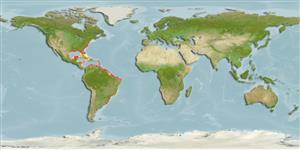Common names from other countries
Environment: milieu / climate zone / depth range / distribution range
Ecologie
; diepteverspreiding 0 - 68 m (Ref. 104365). Tropical, preferred 25°C (Ref. 107945); 43°N - 35°S, 98°W - 33°W (Ref. 3446)
Western Atlantic: from Cape Cod, Massachusetts, to the West Indies and Brazil.
Length at first maturity / Size / Gewicht / Leeftijd
Maturity: Lm ? range ? - ? cm Max length : 7.6 cm SHL mannelijk/geslacht niet bekend; (Ref. 78146)
Equivalved, oval in shape. Size range: 2.8-7.6 cm shell length. Shell length to height ratio = 1.16 (Ref. 78148). Shell depth reaching 70% of height (Ref. 78152).
In the USA, this species remains a potential fishery resource. From the late 1990s to early 2000s, wild stocks of this species are the target of a small-scale fishery in North Carolina (Ref. 78154) and the eastern coast of Virginia with exports primarily as ethnic food to Chicago, New York, Los Angeles and Washington D.C. (Ref. 78152).
Sexes are separate with low incidence of hermaphrodism (2.17%). Males dominant (m/f=2.68). Peak in gonadal pattern in late spring to early summer (45% ripe in May) and a minor peak in winter (21% ripe in December). Dribble spawning likely strategy to extend spawning period and increase reproductive success.
Turgeon, D.D., J.F. Quinn Jr., A.E. Bogan, E.V. Coan, F.G. Hochberg, W.G. Lyons, P.M. Mikkelsen, R.J. Neves, C.F.E. Roper, G. Rosenberg, B. Roth, A. Scheltema, F.G. Thompson, M. Vecchione and J.D. Willams. 1998. (Ref. 1667)
Status op de Rode Lijst van het IUCN (Ref. 130435: Version 2024-1)
Status bij CITES (Ref. 108899)
Not Evaluated
Not Evaluated
Gevaarlijk voor mensen
Harmless
Gebruik door de mens
Visserij: van minder commercieel belang; Aquacultuur: experimenteel
FAO - Visserij: landings | FishSource | Sea Around Us
Tools
Internet-bronnen
Estimates based on models
Preferred temperature
(Ref.
115969): 14.5 - 28, mean 25.4 (based on 490 cells).
Weerstandsvermogen
Hoog, minimale populatieverdubbelingstijd minder dan 15 maanden (K=0.45; tm=5).
Kwetsbaarheid
Moderate vulnerability (37 of 100).
